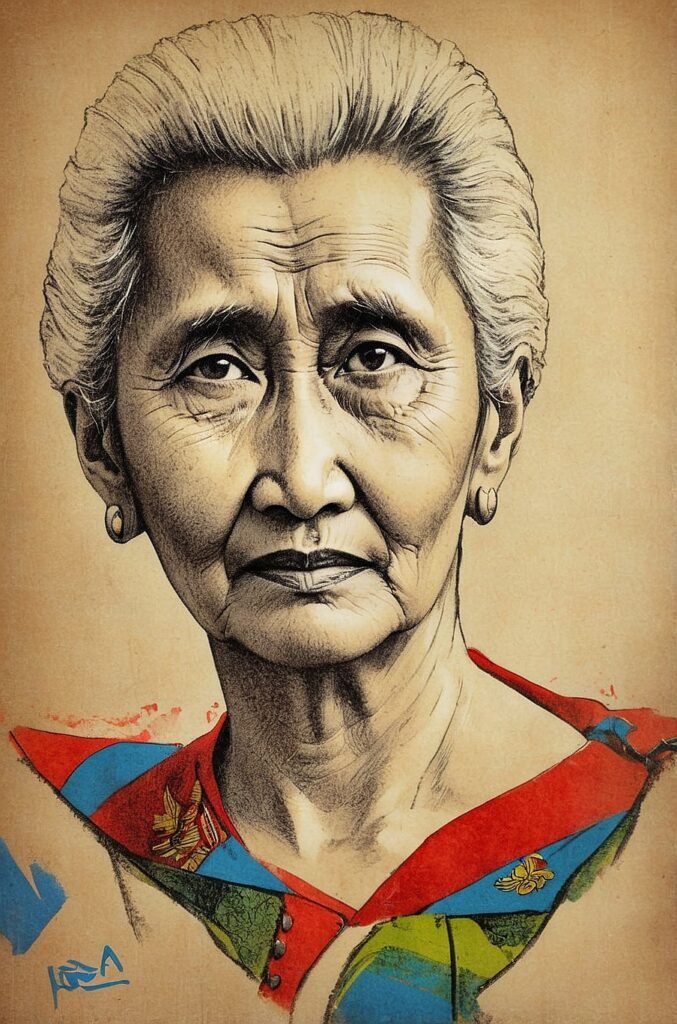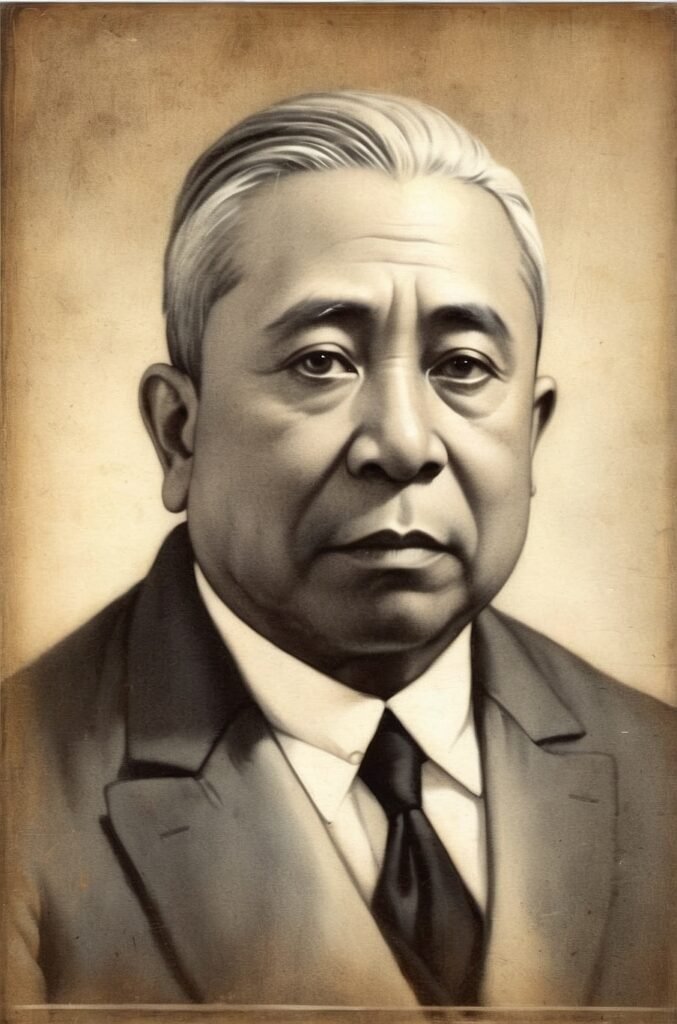Agueda Kahabagan, also known as “Henerala Agueda” or simply “Generala,” stands as a remarkable figure in Philippine history. As one of the few documented female military leaders during the Philippine Revolution against Spanish colonial rule and the subsequent Philippine-American War, Kahabagan’s story is a testament to the strength, courage, and resilience of Filipino women in the face of oppression. This blog post delves into the life, achievements, and lasting legacy of Agueda Kahabagan, exploring her role in shaping the course of Philippine independence and her significance as a symbol of female empowerment in a male-dominated era.
Early Life and Background
Birth and Family
Agueda Kahabagan was born in 1869 in the town of Santa Cruz, Laguna, a province in the southern part of Luzon island in the Philippines. The details of her early life remain somewhat obscure, as historical records from this period are often incomplete or contradictory. However, it is known that Kahabagan was born into a period of growing unrest and dissatisfaction with Spanish colonial rule, which had dominated the Philippine archipelago for over three centuries.
Education and Upbringing
Like many Filipino women of her time, Kahabagan’s formal education was likely limited. The Spanish colonial system generally did not prioritize education for native Filipinos, particularly women. Despite these limitations, Kahabagan demonstrated a keen intellect and a strong sense of justice from a young age. It is believed that she was exposed to the ideas of reform and revolution through the growing nationalist movement that was gaining momentum in the late 19th century.
Social and Political Climate
To understand Kahabagan’s journey, it is crucial to contextualize the era in which she lived. The late 19th century in the Philippines was marked by significant social and political upheaval. The ilustrados, or educated class, were beginning to question Spanish authority and advocate for reforms. This period saw the rise of prominent figures such as José Rizal, Andrés Bonifacio, and Emilio Aguinaldo, who would play pivotal roles in the Philippine Revolution.
The Philippine Revolution and Kahabagan’s Emergence
Outbreak of the Revolution
The Philippine Revolution officially began in 1896, sparked by the discovery of the Katipunan, a secret revolutionary society founded by Andrés Bonifacio. The revolution quickly spread across Luzon and other parts of the archipelago, with various provinces rising up against Spanish rule. It was in this tumultuous environment that Agueda Kahabagan first emerged as a revolutionary figure.
Kahabagan’s Involvement
While the exact details of Kahabagan’s entry into the revolutionary movement are not well-documented, it is believed that she joined the cause sometime in 1896 or 1897. Her involvement in the revolution was notable not only for her gender but also for the leadership role she quickly assumed. Kahabagan demonstrated exceptional bravery and tactical skill, earning her the respect of both male and female revolutionaries.
Military Leadership
Kahabagan’s most significant contribution to the revolution was her role as a military leader. She commanded troops in several engagements against Spanish forces, particularly in her home province of Laguna. Her leadership style was characterized by a combination of strategic thinking and personal courage. Kahabagan often led her troops from the front, wielding a rifle and a bolo (a type of large knife or machete) in battle.
The “Generala” in Action
Notable Battles and Campaigns
While specific details of Kahabagan’s military engagements are limited, historical accounts mention her participation in several key battles. One of the most notable was the Battle of Laguna in 1897, where she led a contingent of revolutionary forces against Spanish troops. Her forces were reported to have inflicted significant casualties on the enemy while minimizing losses among her own troops.
Tactical Approach
Kahabagan’s tactical approach was influenced by the guerrilla warfare strategies employed by many Filipino revolutionaries. She utilized the terrain to her advantage, employing hit-and-run tactics and ambushes to overcome the superior firepower of the Spanish forces. Her knowledge of the local geography and her ability to mobilize support from the civilian population proved invaluable in these engagements.
Leadership Style
Accounts of Kahabagan’s leadership style describe her as a charismatic and inspirational figure. She was known for her ability to rally troops and maintain morale even in the face of adversity. Her presence on the battlefield was said to have a galvanizing effect on her soldiers, many of whom were inspired by the sight of a woman leading them into combat.
Kahabagan’s Role in the Philippine-American War
Transition from Spanish to American Rule
The conclusion of the Spanish-American War in 1898 brought an end to Spanish colonial rule in the Philippines. However, this was quickly followed by the outbreak of the Philippine-American War as the United States sought to establish control over the archipelago. Kahabagan, like many Filipino revolutionaries, transitioned from fighting against Spanish forces to resisting American occupation.
Continued Resistance
During the Philippine-American War, Kahabagan continued her role as a military leader. She adapted her tactics to face the new challenges posed by American forces, which were better equipped and more numerous than their Spanish predecessors. Kahabagan’s forces engaged in several skirmishes with American troops, particularly in the Laguna and Batangas regions.
Capture and Aftermath
Historical records indicate that Kahabagan was eventually captured by American forces in 1902. The exact circumstances of her capture and her subsequent fate are not well-documented. Some accounts suggest that she was imprisoned for a time, while others indicate that she may have been released or escaped. Regardless of the specific outcome, Kahabagan’s active military role appears to have ended with her capture.
Legacy and Historical Significance
Recognition as “Generala”
One of the most significant aspects of Kahabagan’s legacy is her recognition as a “Generala” or female general. This title was not merely honorific but reflected her actual military rank and command responsibilities. Kahabagan’s status as a general is particularly noteworthy given the patriarchal nature of both Filipino society at the time and the military structure of the revolutionary forces.
Impact on Women’s Roles
Kahabagan’s achievements challenged prevailing notions about women’s capabilities and roles in society. Her leadership during the revolution and subsequent war demonstrated that women could be effective military commanders and political leaders. This had a profound impact on how women were perceived in the context of the nationalist movement and beyond.
Historical Documentation
The table below summarizes key information about Agueda Kahabagan:
| Aspect | Details |
|---|---|
| Full Name | Agueda Kahabagan |
| Birth Year | 1869 |
| Birthplace | Santa Cruz, Laguna, Philippines |
| Known As | “Henerala Agueda” or “Generala” |
| Military Rank | General |
| Active Years | 1896-1902 (approximate) |
| Key Battles | Battle of Laguna (1897), various engagements during Philippine-American War |
| Weapons of Choice | Rifle and Bolo |
| Capture | 1902 by American forces |
Challenges in Historical Research
Limited Documentation
One of the primary challenges in studying Agueda Kahabagan’s life and contributions is the limited nature of historical documentation. Many records from the revolutionary period were lost or destroyed during the conflicts or in subsequent years. This scarcity of primary sources has made it difficult for historians to construct a comprehensive narrative of Kahabagan’s life and military career.
Gender Bias in Historical Records
The historical record of the Philippine Revolution and the Philippine-American War, like many historical accounts, tends to focus primarily on male figures. This gender bias in documentation has likely resulted in the underrepresentation of women’s contributions, including those of Kahabagan. Efforts to uncover and highlight the roles of women in these conflicts have been ongoing, but challenges remain in piecing together a complete picture.
Conflicting Accounts
Where information about Kahabagan does exist, there are often conflicting accounts of her activities and achievements. This is not uncommon for historical figures from this period, particularly those involved in guerrilla warfare and resistance movements. Reconciling these varying accounts remains an ongoing task for historians and researchers.
Kahabagan in Popular Culture and Memory
Commemorations and Memorials
Despite the challenges in historical documentation, efforts have been made to commemorate Agueda Kahabagan’s contributions to Philippine history. Several local memorials and historical markers in Laguna province mention her role in the revolution. These serve as important reminders of her legacy and help to keep her story alive in public memory.
Representation in Media
In recent years, there has been growing interest in Kahabagan’s story among Filipino filmmakers, writers, and artists. While no major biographical films or novels have been produced about her life, she is often included in documentaries and historical dramas about the revolutionary period. These portrayals help to introduce her story to new generations of Filipinos.
Educational Initiatives
Kahabagan’s story has increasingly been incorporated into Philippine history curricula, particularly in discussions about women’s roles in the revolution. This educational focus helps to provide a more balanced and inclusive view of the country’s struggle for independence, highlighting the contributions of both men and women to the cause.
Comparative Analysis: Women in Revolution
To provide context for Kahabagan’s achievements, it is useful to consider her role alongside other women who played significant parts in revolutionary movements around the world. The following table offers a comparative view:
| Name | Country | Period | Role |
|---|---|---|---|
| Agueda Kahabagan | Philippines | 1896-1902 | Military general in Philippine Revolution and Philippine-American War |
| Lakshmi Bai | India | 1857-1858 | Military leader in Indian Rebellion of 1857 |
| Manuela Sáenz | South America | 1819-1830 | Revolutionary leader in South American independence movements |
| Louise Michel | France | 1871 | Leader in Paris Commune |
| Constance Markievicz | Ireland | 1916-1923 | Military officer in Easter Rising and Irish War of Independence |
This comparison illustrates that while Kahabagan’s role was exceptional, she was part of a broader global trend of women taking active, leadership roles in revolutionary movements during the 19th and early 20th centuries.
Historiographical Debates and Modern Interpretations
Reassessing Women’s Roles
In recent decades, there has been a growing movement among historians to reassess and highlight the roles of women in revolutionary and military contexts. This reevaluation has led to increased interest in figures like Agueda Kahabagan, as scholars seek to provide a more comprehensive and inclusive account of historical events. This shift in focus has not only brought attention to individual women like Kahabagan but has also prompted a broader reconsideration of how gender dynamics influenced revolutionary movements.
Nationalism and Feminist Perspectives
The study of Kahabagan’s life and achievements sits at the intersection of nationalist and feminist historical perspectives. From a nationalist viewpoint, her story is part of the broader narrative of Philippine resistance to colonial rule and the struggle for independence. From a feminist perspective, Kahabagan’s role challenges traditional gender norms and provides an example of female leadership in a male-dominated sphere. Modern historians often seek to balance these perspectives, recognizing the complexity of Kahabagan’s position as both a nationalist hero and a pioneer for women’s participation in military and political affairs.
Challenges of Mythologization
As with many historical figures, particularly those from periods of national struggle, there is a risk of Kahabagan’s story becoming mythologized. While celebration of her achievements is important, historians caution against exaggeration or embellishment of her role. The challenge lies in honoring her contributions while maintaining historical accuracy and contextualizing her actions within the broader scope of the revolutionary movement.
Conclusion
Agueda Kahabagan’s story is a compelling testament to the often-overlooked role of women in shaping the course of Philippine history. As a military leader during both the Philippine Revolution and the Philippine-American War, she challenged societal norms and demonstrated that women could be effective commanders in times of conflict. Her title of “Generala” was not merely symbolic but a reflection of her actual rank and responsibilities on the battlefield.
Despite the limitations in historical documentation, Kahabagan’s legacy continues to inspire and intrigue. Her life serves as a reminder of the diverse cast of characters who contributed to the Philippine struggle for independence, extending beyond the well-known male figures who often dominate historical narratives. The challenges in piecing together her story also highlight the broader issues of gender bias in historical record-keeping and the need for continued research to uncover and celebrate the contributions of women to national movements.
As Philippines continues to grapple with questions of national identity, gender equality, and historical memory, figures like Agueda Kahabagan offer important points of reference. Her story encourages a more inclusive understanding of the country’s past and provides a powerful example of female leadership for future generations.
The ongoing efforts to commemorate Kahabagan’s life and integrate her story into educational curricula are crucial steps in ensuring that her contributions are not forgotten. As research continues and new information potentially comes to light, our understanding of Agueda Kahabagan and her role in Philippine history may evolve, but her significance as a symbol of female empowerment and patriotic dedication is likely to endure.
Disclaimer: This blog post is based on available historical information and scholarly interpretations as of April 2024. While every effort has been made to ensure accuracy, the limited nature of historical records from the period may result in some uncertainties. Readers are encouraged to consult multiple sources and the latest historical research for the most up-to-date information on Agueda Kahabagan and the Philippine revolutionary period. If you notice any inaccuracies or have additional verified information to contribute, please contact us so we can update and improve this article promptly.




